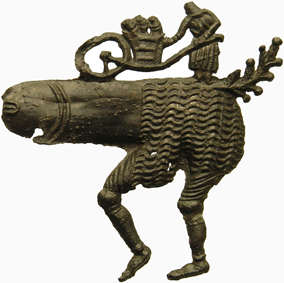De insignes die in de tentoonstelling getoond worden, zijn:
Inv.nr. 1300, Heilig & Profaan 1, afb. 622, Twee gevleugelde fallusdieren met een bel onder een boom, gevonden in Amsterdam.
Inv.nr. 2026, Heilig & Profaan 1, afb. 623, Fallusboom met vulva, gevonden in Nieuwlande
Inv.nr. 1858, Heilig & Profaan 1, afb. 631, Fallusdier met daarop een vrouw met een kruiwagen met drie fallussen, gevonden in Nieuwlande
Inv.nr. 3582, Heilig & Profaan 2, afb. 1761, Gevleugelde fallus, gevonden in Dordrecht
Inv.nr. 3209, Heilig & Profaan 2, afb. 1769, Gekroonde fallus te paard met kruisboog, gevonden in ‘s-Hertogenbosch
Inv.nr. 3055, Heilig & Profaan 2, afb. 1770, Gekroonde vulva te paard met pijl en boog, gevonden in Westenschouwen
De insignes, voorzien van begeleidende teksten door dr. H. van Asperen en drs. W. Piron, zijn opgenomen in de catalogus die bij de tentoonstelling wordt uitgegeven.
Een excerpt uit de catalogus:
‘The genitalia badges from a Dutch private collection illustrate the fascinating pictorial language of the 1400s beautifully. One of the simplest ones on the exhibition shows a phallus with wings. The winged heart was a symbol of love. The heart was considered the seat of love and the wings referred to the classical god of love: Amor. The winged phallus forms an obvious counterpart to the winged heart. Whereas the heart could refer to the love between God and man, between fellow men, between man and woman, the phallus refers to the physical aspect of love. The badge is part of a larger group consisting mostly of badges in the shape of phallic animals like the one depicted on another badge from the Van Beuningen collection; it depicts a walking phallus with a woman pushing barrows of phalluses (inv. 1858). The greater part of these phallic animals have tails and legs, sometimes they have wings. Occasionally, they wear a bell around their ‘neck’. These are elements that point to animals. On the other hand, these phalluses have human feet. They even wear shoes. The testicles sometimes look like medieval breeches.’
Voor meer informatie: www.landesmuseum.de

Object: Lopende fallus waarop een vrouw met kruiwagen waarin drie fallussen
Datering: 1400-1450
Materiaal: lood-tin
Afmeting: 56 x 55 mm
Collectie: Langbroek, Familie Van Beuningen, inv. 1858